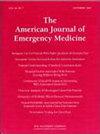Hepatitis C testing and linkage to care in a safety-net hospital emergency department
IF 2.7
3区 医学
Q1 EMERGENCY MEDICINE
引用次数: 0
Abstract
Background and purpose
In 2020, the CDC expanded hepatitis C (HCV) screening recommendations to include universal screening for persons 18 and older. We implemented universal screening in the emergency department (ED) within a safety-net health system. We aimed to measure HCV prevalence and linkage to care (LTC) outcomes in the ED and compare them to the outpatient clinics within the same health system.
Methods
Patients aged 18–79 without HCV qualified for screening. We measured prevalence of both anti-HCV+ (exposure) and HCV RNA+ (active infection). Those with active HCV were flagged for LTC and their charts were followed for outcomes. HCV prevalence and LTC in the ED were compared to those in outpatient clinics over the same time.
Results
9511 patients were screened for HCV from 2019 to 2022 in the ED. 6.9 % (659) were anti-HCV+. 54.9 % (320 of 582) of anti-HCV+ individuals or 3.4 % of those screened (320 of 9511) were HCV RNA+. The LTC rate was 24.1 % (77 of 320) and a total of 56 individuals (17.8 % of all HCV RNA+ ED patients, 72.7 % of those linked) initiated treatment. HCV prevalence was higher in the ED compared to the outpatient clinic setting. Demographics and LTC rates also significantly differed between these two cohorts.
Conclusions
We identified a higher HCV prevalence in the ED relative to the outpatient clinic setting and significant need for improvement in LTC and HCV treatment initiation. Our findings suggest universal screening is an important tool to diagnose HCV infections but may require novel strategies for improved LTC and treatment initiation.
丙型肝炎检测及与安全网医院急诊科护理的联系
背景和目的2020年,美国疾病控制与预防中心扩大了丙型肝炎(HCV)筛查建议,将18岁及以上人群的普遍筛查纳入其中。我们在安全网卫生系统内的急诊科(ED)实施了普遍筛查。我们的目的是测量急诊科的HCV患病率和与护理的联系(LTC)结果,并将其与同一卫生系统内的门诊进行比较。方法18-79岁无HCV的患者符合筛查条件。我们测量了抗HCV+(暴露)和HCV RNA+(活动性感染)的患病率。那些HCV活动性的患者被标记为LTC,他们的图表被跟踪观察结果。在同一时间,将急诊科的HCV患病率和LTC与门诊进行比较。结果2019年至2022年,ED筛查了9511例HCV患者,其中6.9%(659例)为抗HCV+。54.9%(582 / 320)的抗HCV阳性个体或3.4%(9511 / 320)的筛选者为HCV RNA+。LTC率为24.1%(320例中有77例),共有56例(占所有HCV RNA+ ED患者的17.8%,占相关患者的72.7%)开始治疗。与门诊相比,急诊科的HCV患病率更高。人口统计学和LTC率在这两个队列之间也存在显著差异。结论:我们发现,与门诊相比,急诊科的HCV患病率较高,并且在LTC和HCV治疗开始方面有明显的改善需求。我们的研究结果表明,普遍筛查是诊断HCV感染的重要工具,但可能需要新的策略来改善LTC和治疗启动。
本文章由计算机程序翻译,如有差异,请以英文原文为准。
求助全文
约1分钟内获得全文
求助全文
来源期刊
CiteScore
6.00
自引率
5.60%
发文量
730
审稿时长
42 days
期刊介绍:
A distinctive blend of practicality and scholarliness makes the American Journal of Emergency Medicine a key source for information on emergency medical care. Covering all activities concerned with emergency medicine, it is the journal to turn to for information to help increase the ability to understand, recognize and treat emergency conditions. Issues contain clinical articles, case reports, review articles, editorials, international notes, book reviews and more.

 求助内容:
求助内容: 应助结果提醒方式:
应助结果提醒方式:


